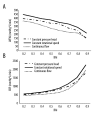Hemodynamic effects of various support modes of continuous flow LVADs on the cardiovascular system: a numerical study
- PMID: 24793178
- PMCID: PMC4020910
- DOI: 10.12659/MSM.890824
Hemodynamic effects of various support modes of continuous flow LVADs on the cardiovascular system: a numerical study
Abstract
Background: The aim of this study was to determine the hemodynamic effects of various support modes of continuous flow left ventricular assist devices (CF-LVADs) on the cardiovascular system using a numerical cardiovascular system model.
Material and methods: Three support modes were selected for controlling the CF-LVAD: constant flow mode, constant speed mode, and constant pressure head mode of CF-LVAD. The CF-LVAD is established between the left ventricular apex and the ascending aorta, and was incorporated into the numerical model. Various parameters were evaluated, including the blood assist index (BAI), the left ventricular external work (LVEW), the energy of blood flow (EBF), pulsatility index (PI), and surplus hemodynamic energy (SHE).
Results: The results show that the constant flow mode, when compared to the constant speed mode and the constant pressure head mode, increases LVEW by 31% and 14%, and EBF by 21% and 15%, respectively, indicating that this mode achieved the best ventricular unloading among the 3 support modes. As BAI is increased, PI and SHE are gradually decreased, whereas PI of the constant pressure head reaches the maximum value.
Conclusions: The study demonstrates that the continuous flow control mode of the CF-LVAD may achieve the highest ventricular unloading. In contrast, the constant rotational speed mode permits the optimal blood perfusion. Finally, the constant pressure head strategy, permitting optimal pulsatility, should optimize the vascular function.
Figures






Similar articles
-
Improving arterial pulsatility by feedback control of a continuous flow left ventricular assist device via in silico modeling.Int J Artif Organs. 2014 Oct;37(10):773-85. doi: 10.5301/ijao.5000328. Epub 2014 May 13. Int J Artif Organs. 2014. PMID: 24970558
-
Hemodynamic effects of support modes of LVADs on the aortic valve.Med Biol Eng Comput. 2019 Dec;57(12):2657-2671. doi: 10.1007/s11517-019-02058-y. Epub 2019 Nov 10. Med Biol Eng Comput. 2019. PMID: 31707689
-
Rotary pump speed modulation for generating pulsatile flow and phasic left ventricular volume unloading in a bovine model of chronic ischemic heart failure.J Heart Lung Transplant. 2015 Jan;34(1):122-131. doi: 10.1016/j.healun.2014.09.017. Epub 2014 Sep 28. J Heart Lung Transplant. 2015. PMID: 25447573
-
Clinical Implications of Physiologic Flow Adjustment in Continuous-Flow Left Ventricular Assist Devices.ASAIO J. 2017 May/Jun;63(3):241-250. doi: 10.1097/MAT.0000000000000477. ASAIO J. 2017. PMID: 28459742 Review.
-
Endothelial Function in Patients With Continuous-Flow Left Ventricular Assist Devices.Angiology. 2021 Jan;72(1):9-15. doi: 10.1177/0003319720946977. Epub 2020 Aug 6. Angiology. 2021. PMID: 32757767 Review.
Cited by
-
Computational Analysis of Intra-Ventricular Flow Pattern Under Partial and Full Support of BJUT-II VAD.Med Sci Monit. 2017 Feb 27;23:1043-1054. doi: 10.12659/msm.900481. Med Sci Monit. 2017. PMID: 28239142 Free PMC article.
-
Mathematical modeling of cardiac function to evaluate clinical cases in adults and children.PLoS One. 2019 Oct 31;14(10):e0224663. doi: 10.1371/journal.pone.0224663. eCollection 2019. PLoS One. 2019. PMID: 31671136 Free PMC article.
-
Effect of Different Rotational Directions of BJUT-II VAD on Aortic Swirling Flow Characteristics: A Primary Computational Fluid Dynamics Study.Med Sci Monit. 2016 Jul 21;22:2576-88. doi: 10.12659/msm.899313. Med Sci Monit. 2016. PMID: 27440399 Free PMC article.
-
Pulsatile Support Mode of BJUT-II Ventricular Assist Device (VAD) has Better Hemodynamic Effects on the Aorta than Constant Speed Mode: A Primary Numerical Study.Med Sci Monit. 2016 Jul 1;22:2284-94. doi: 10.12659/msm.896291. Med Sci Monit. 2016. PMID: 27363758 Free PMC article.
-
Effects of Pulsatile Frequency of Left Ventricular Assist Device (LVAD) on Coronary Perfusion: A Numerical Simulation Study.Med Sci Monit. 2020 Sep 17;26:e925367. doi: 10.12659/MSM.925367. Med Sci Monit. 2020. PMID: 32940255 Free PMC article.
References
-
- Jhun CS, Reibson JD, Cysyk JP. Effective ventricular unloading by left ventricular assist device varies with stage of heart failure: cardiac simulator study. ASAIO J. 2011;57:407–13. - PubMed
-
- Hayward CS, Salamonsen R, Keogh AM, et al. Effect of alteration in pump speed on pump output and left ventricular filling with continuous-flow left ventricular assist device. ASAIO J. 2011;57:495–500. - PubMed
-
- Travis AR, Giridharan GA, Pantalos GM, et al. Vascular pulsatility in patients with a pulsatile- or continuous-flow ventricular assist device. J Thorac Cardiovasc Surg. 2007;133:517–24. - PubMed
-
- Tuzun E, Eya K, Chee HK, et al. Myocardial hemodynamics, physiology, and perfusion with an axial flow left ventricular assist device in the calf. ASAIO J. 2004;50:47–53. - PubMed
-
- Ootaki Y, Kamohara K, Akiyama M, et al. Phasic coronary blood flow pattern during a continuous flow left ventricular assist support. Eur J Cardiothorac Surg. 2005;28:711–16. - PubMed
Publication types
MeSH terms
LinkOut - more resources
Full Text Sources
Other Literature Sources
Research Materials
Miscellaneous

